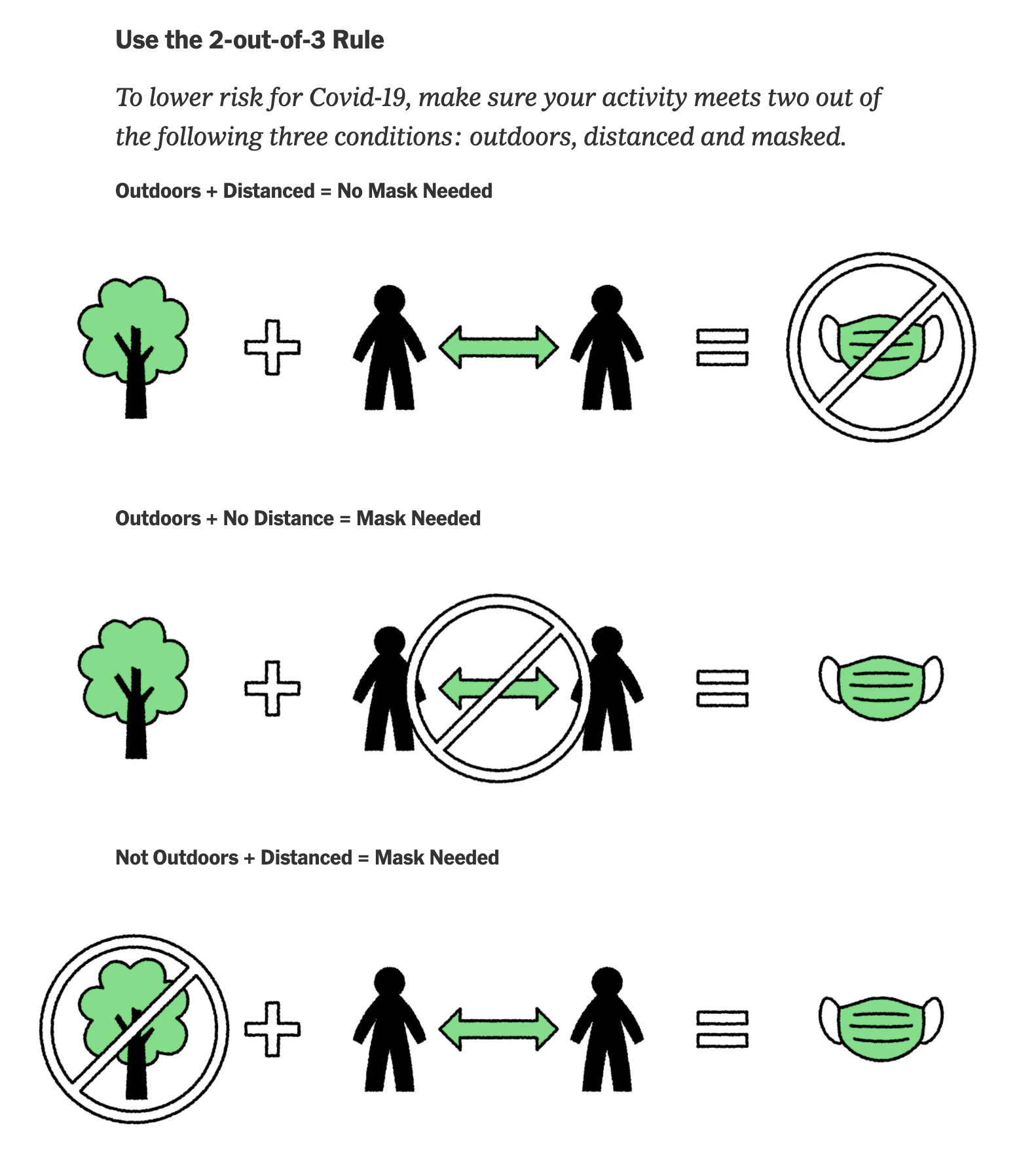Two out of three ain’t bad: Rules for when you can skip the mask

Tara Parker-Pope, New York Times https://www.nytimes.com/2021/04/22/well/live/covid-masks-outdoors.html
Open face in the open air: The “2 out of 3” Rule for Masking
In a previous post I explained why at this time, being fully vaccinated does not mean you can ditch your face masks–not yet, anyway.
Since this brand-new virus exploded on the scene in early 2020, we’ve learned a lot about how it spreads from person to person. Yes, this means that the best advice from public health professionals has changed over time–because our knowledge base has changed too.
It is now clear that SARS-CoV-2, the coronavirus that causes COVID-19, is primarily spread when an infected person exhales and another person inhales the same virus-laden air.
Where is this most likely to happen?
- Indoors
- When the people are close to each other
- When the people are together for a longer time
- Where the air circulation is poor
These are the circumstances under which it’s important to wear a face mask. The face mask traps some of the water droplets you exhale. If you have virus in your breath, it’s in those droplets.
But what about outside in the fresh air?
In the vast ocean of outside air, any virus-containing droplets get diluted and dispersed. If people cluster together, or breathe heavily side-by-side for a long time (two jogging partners, for example), sure, it’s possible for one to infect another. But if a fully vaccinated person is walking down a path and passes another human, the COVID risk is essentially zero.
I do a lot of hiking in the great outdoors. I carry a mask with me in case I come upon a situation where there’s a cluster of people (such as at a scenic viewpoint, perhaps) but I do not wear a mask when simply passing people on a trail.
Do I get some dirty looks? Once in a while. But in the words of Shannon Palus in Slate Magazine,
“masking shouldn’t be about signaling what side you’re on—it should be about using a tool in response to risk. Being overly vigilant about masks when they are not important makes it more difficult to keep wearing them when they are.”
An expert consensus on this is building (see for example this New England Journal of Medicine blog). It will grow with the US vaccination rate.
New York Times columnist Tara Parker-Pope wrote an article asking, Do We Still Need to Keep Wearing Masks Outdoors? The author cites Linsey Marr, a professor of civil and environmental engineering at Virginia Tech and one of the world’s leading experts on viral transmission, for a simple two-out-of-three rule for deciding when to wear a mask in public spaces or when she doesn’t know everyone’s vaccination status:
“In these situations, she makes sure she’s meeting two out of three conditions: outdoors, distanced and masked. “If you’re outdoors, you either need to be distanced or masked,” she said. “If you’re not outdoors, you need to be distanced and masked.”
Parker-Pope then created the handy graphic you see at the top of this post.
Happy hiking!
Have you been vaccinated yet? If you live in California and are age 16 or older, you’re eligible now!
Visit https://myturn.ca.gov/ to find appointments for a FREE vaccine near you.
“Already, the rollout of vaccines has dramatically changed the dynamics of the U.S. epidemic. Hospitalization and death rates among older adults — the population with the highest immunization coverage — have plummeted, while hospitalizations among younger adults have also started to come down more recently. Whereas for the first year of the pandemic hospitalizations and deaths would follow case counts in predictable patterns, experts now speak of vaccines “decoupling” those metrics because they are so powerfully protective against the worst outcomes of the disease.” StatNews April 23, 2021
Amy Rogers, MD, PhD, is a Harvard-educated scientist, novelist, journalist, and educator. Learn more about Amy’s science thriller novels, or download a free ebook on the scientific backstory of SARS-CoV-2 and emerging infections, at AmyRogers.com.


